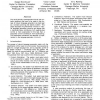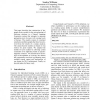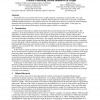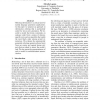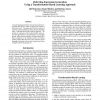COLING
1992
15 years 1 months ago
1992
We describe a method and its implementation for self-monitoring during natural language generation. In situations of communication where the generation of ambiguous utterances sho...
90
Voted
IJCAI
1989
15 years 1 months ago
1989
The set of partially interdependent lexical and syntactic decisions that have to be made in the process of natural language generation are best seen as a complex planning and sear...
ANLP
2000
15 years 2 months ago
2000
This paper introduces an approach to representing the kinds of information that components in a natural language generation (NLG) system will need to communicate to one another. T...
88
Voted
ANLP
2000
15 years 2 months ago
2000
In natural language generation, different generation tasks often interact with each other in a complex way, which is hard to capture in the pipeline architecture described by Reit...
86
Voted
ACL
1998
15 years 2 months ago
1998
The view that communication is a form of action serving a variety of specific functions has had a tremendous impact on the philosophy of language and on computational linguistics....
77
Voted
RANLP
2003
15 years 2 months ago
2003
We present Xenon, a natural language generation system capable of distinguishing between nearsynonyms. It integrates a near-synonym choice module with an existing sentence realiza...
100
click to vote
NAACL
2003
15 years 2 months ago
2003
This paper describes the construction of language choice models for the microplanning of discourse relations in a Natural Language Generation system that attempts to generate appr...
99
Voted
HCI
2001
15 years 2 months ago
2001
For people who use text-based web browsers, graphs, diagrams, and pictures are inaccessible. Yet, such diagrams are quite prominent in documents commonly found on the web. In this...
110
Voted
ACL
2003
15 years 2 months ago
2003
Ordering information is a critical task for natural language generation applications. In this paper we propose an approach to information ordering that is particularly suited for ...
88
Voted
FLAIRS
2006
15 years 2 months ago
2006
A natural language generation system must generate expressions that allow a reader to identify the entities to which they refer. This paper describes the creation of referring-exp...

